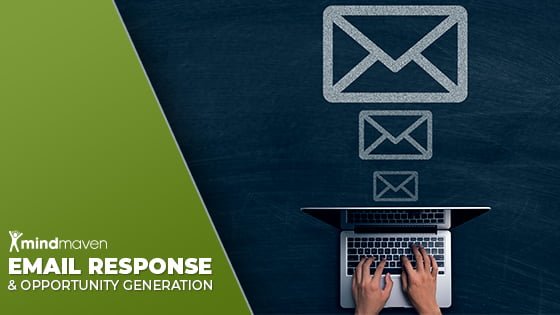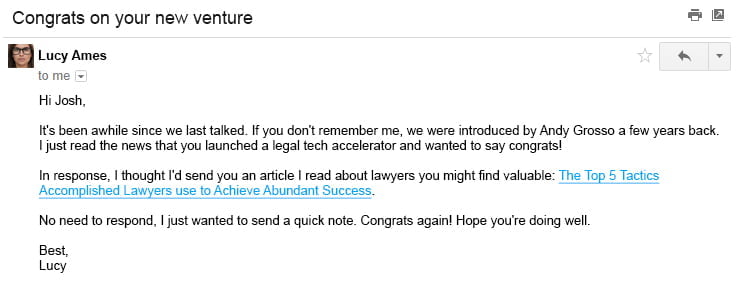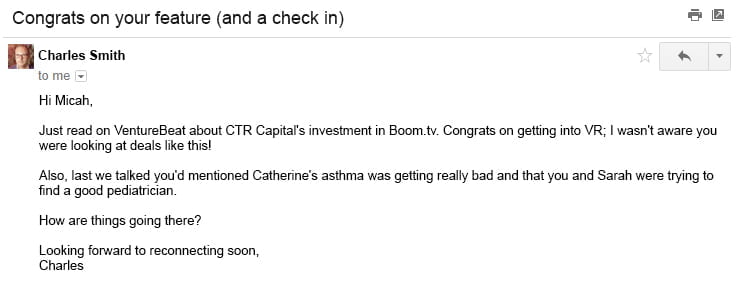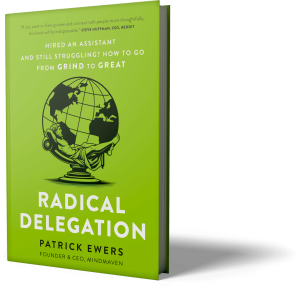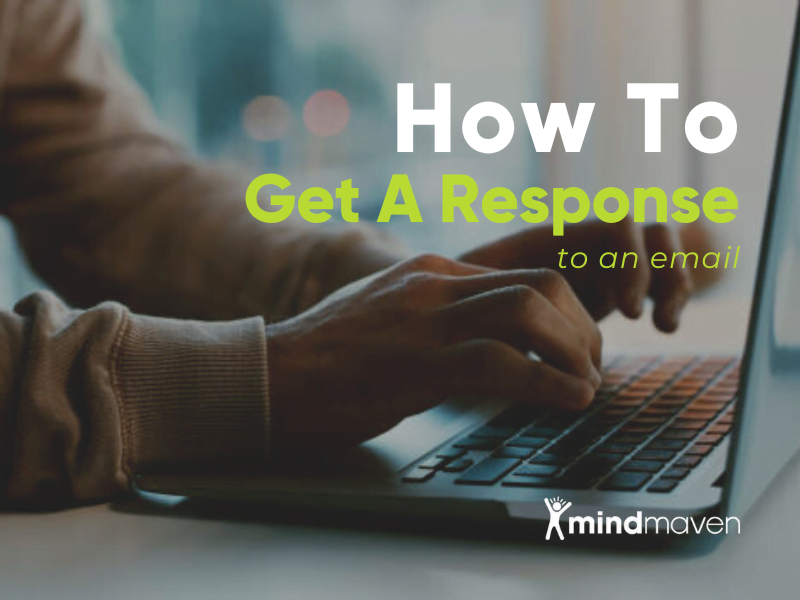
How To Get an Email Response
How to get a response to an email is a question we often help Mindmaven clients with. So we thought it could be helpful to share some top tips.
If you struggle with getting responses to emails or want to know how to politely follow up on unanswered emails, then this article is for you.
In this article, we discuss…
- 3 key factors that drive email response rates
- 3 email response tips — with real-life email examples
- How to follow up on emails that have had no response
We will look at tried and tested ways to increase email engagement, with email reply examples, and take you through exactly how to politely follow up on an unanswered email.
To see how to get a response to an email in action, we’ve also made this quick little video showing how a few simple tweaks can turn a so-so email into a stellar one. Watch this over-the-shoulder video example to see how you can improve an email in less than two minutes.
How To Get Someone To Respond To Your Email?
When considering how to get an email response, or a follow-up on an email that has no response, it’s important, first of all, not to take it personally.
According to a global Radicati study, the average person sends around 40 emails a day. Of course, that’s only the average, and if you’re anything like us or many of our clients, you probably send considerably more.
But regardless of how many emails you’re sending, you and I both know you aren’t writing them for the practice. Most of the time, you’re writing an email because you want a response.
The problem is, the same study found that the average person receives 141 emails a day.
To put that in perspective, only about a quarter of emails get a response, while three-quarters sit unanswered.
If you’ve ever spent precious time writing emails that never got a response, you know how frustrating that can be.
That’s why I want to share three proven strategies to write emails that dramatically increase the likelihood of getting an email response (and introduce you to a powerful new resource to learn more tactics).
To help with that, it’s important to first understand the underlying factors that determine email engagement and the likelihood of someone replying to your emails.
The 3 Key Factors That Drive Email Response Rates
When your email arrives in your recipient’s inbox, there are three factors that determine the likelihood of them opening and responding to you.
1. The Quality of Your Relationship With the Recipient
The better the relationship you two share, the more likely you are to get a response. For example, a close friend is much more likely to reply than a complete stranger.
2. The Demand on Your Recipient’s Attention
Someone compulsively checking their inbox is pretty likely to respond to your emails. A busy CEO, on the other hand, may not have the time to respond.
3. The Relevancy of Your Email
The wrong message to the right person, even at the right time, isn’t likely to get a reply. In other words, if you’re (metaphorically) trying to sell ice to someone living in the Arctic Circle, you probably aren’t going to get a great response. Your email must make the other person genuinely want to respond, and it must be relevant to them.
Therefore, the better your relationship, the lower the demand on your recipient’s time, and the more relevant your message, the more likely you are to get an email response.
However, you have virtually no control over the first two factors. After all, the quality of the relationship simply is what it is right now. The demand on your recipient’s attention is determined by outside circumstances.
The good news is that you have almost complete control over the relevancy of your email.
That is why, with the right mindset and tactics, it’s entirely possible to write an email so relevant and high-quality that you dramatically influence the likelihood of getting a response.
3 Email Response Tips — With Real-life Email Examples: How To Get a Response to an Email
The following three email response tips show you how to get a response to an email with a tried and tested way to improve email engagement and response rates.
Note: The tips below are an accompaniment to our online program, The Email Response and Opportunity Generation Course. Click here to learn more and activate your special offer for complementary access (usually $29.99)!
#1 Email Response Tip: Send an Email That Doesn’t Require a Response
This might seem a little counter-intuitive, but it’s one of the most effective ways to get a response.
If you know you want to send someone an email asking for a favor—don’t. At least, not yet.
Instead, send an email that doesn’t have an “ask” and doesn’t require a response. This email should be entirely focused on providing value to the other person.
For example,
- Congratulate them for a recent accomplishment or milestone (such as a promotion, anniversary, or new venture)
- Offer a relevant item of value (like a blog post, podcast, or book recommendation)
- Thank them for a favor they did for you in the past (no matter how small, even something as simple as advice they offered)
Then, at the end of the email, specifically state that you’re not expecting a response.
At this point, one of two things will likely happen:
- They’ll either appreciate the email enough to reply anyway, opening the door for you to start a conversation and creating an opportunity for you to make your ask.
- They’ll appreciate the email, but choose not to respond. However, you’ll still be top-of-mind, and when your next email arrives a day or two later—the one where you make your ask—they’ll be much more likely to respond positively.
Let us demonstrate this tip with a quick real-life email example:
Although this tactic might prolong the email exchange, we’ve found it’s often worth the wait because you stack the odds in your favor and influence the likelihood that the recipient will respond to your future emails.
Tip: Want to learn how to deepen relationships with ease? Check out Five 5-Minute Habits to Quickly Deepen Your Personal and Professional Relationships.
#2 Email Response Tip: Make It Personal To Connect on a Deeper Level
Unless you’re reaching out to a completely cold contact, you probably have some sort of relationship with the recipient (even if that “history” is only a single conversation at a networking event).
Hopefully, somewhere in your shared history, you made it a point to uncover something interesting about the other person. For example, personal interests, passions, professional challenges, or background information about their family or education.
You can use this information to ask questions that make your email uniquely personalized to the recipient and increase the likelihood that you will get a response. When it’s clear you aren’t sending a mass email and took the time to write something personal, your recipient is much more likely to respond.
Let me illustrate this concept with an example:
In the example above, it’s clear Charles (the sender) knows that Micah’s (the recipient) daughter has asthma. Knowing this, Charles is able to ask a question that not only reminds Micah of their history, but also shows that Charles truly cares about their relationship and his family.
In our experience, a note like the one above is much more likely to get an email response. After all, wouldn’t you respond to a question related to something you care deeply about?
Tip: Has it been too long and you can’t remember details or shared history? Eliminate this problem in the future by reading If You Forget Everything Else About Your Contacts, Remember This One Thing.
#3 Email Response Tip: Own the Interaction and Be Confident in Your Value
The harsh reality is that even if you do everything right, you still may not get a response.
When that happens, don’t take it personally. It doesn’t necessarily mean anything was wrong with your email, nor does it mean the other person is intentionally ignoring you.
At first, many people are uncomfortable with the idea of following up because they think they’re “pestering” the other person.
Tip: If you’re truly confident in the value you provide—and the relevancy of your ask—following up should be a no-brainer.
In fact, you’d be doing the other person a disservice by not bringing your offer back up to the top of their inbox.
It’s going to feel a little unnatural and uncomfortable at first. But when you push through that, you’ll find many people actually appreciate the reminder.
How Do You Follow Up on an Email That Has No Response?
Most people make the mistake of giving up after one email, assuming the other person isn’t interested. In our experience, that’s rarely the case. Here’s a more likely scenario…
Your recipient saw your email but was too busy to reply. They probably made a mental note to respond later, but, as often happens, something came up, and they simply forgot.
That’s why it’s so important to follow up two or three times over a four-to-six-week span before you close the door on the exchange. In most cases, one follow-up email is all it’ll take to get the response you’re looking for.
How Do You Politely Follow Up on an Unanswered Email?
The first email I recommend sending three days after your original message should be low-pressure and guilt-free. All you’re doing here is bringing your name back to the top of their inbox.
Here’s an example of how to get a response to an email by sending a follow up on an email that has no response.
It’s also a good idea to include your original message underneath your signature, so the recipient doesn’t have to dig through their inbox to find it.
Want More Email Strategies? We’ve Got You Covered.
Email is such a foundational part of doing business you can’t afford to waste time sending emails that sit unanswered.
If this resonates with you—and if the tips on how to get a response to an email have been valuable—we’d like to invite you to our online program, The Email Response and Opportunity Generation Course.
We dive deeper into the exact tried and tested ways to improve email engagement and how to get a response to an email.
We also go into much more detail about how to create a two-week follow-up plan, with practical example templates.
In Email Response and Opportunity Generation, you’ll learn…
- The importance of influence and aligning your “ask” to your recipient.
- How to identify your “Ultimate Ask” to achieve breakthrough response rates.
- How to almost guarantee email replies with an actionable, templatized follow-up game plan.
On top of that, you’ll have access to over 20 real-world email examples to help you write the perfect email.
This is a $29.99 course, but for a limited time, we are offering you this powerful course for free!
If improving your email engagement and response rates is valuable to you, then click here to learn more.

